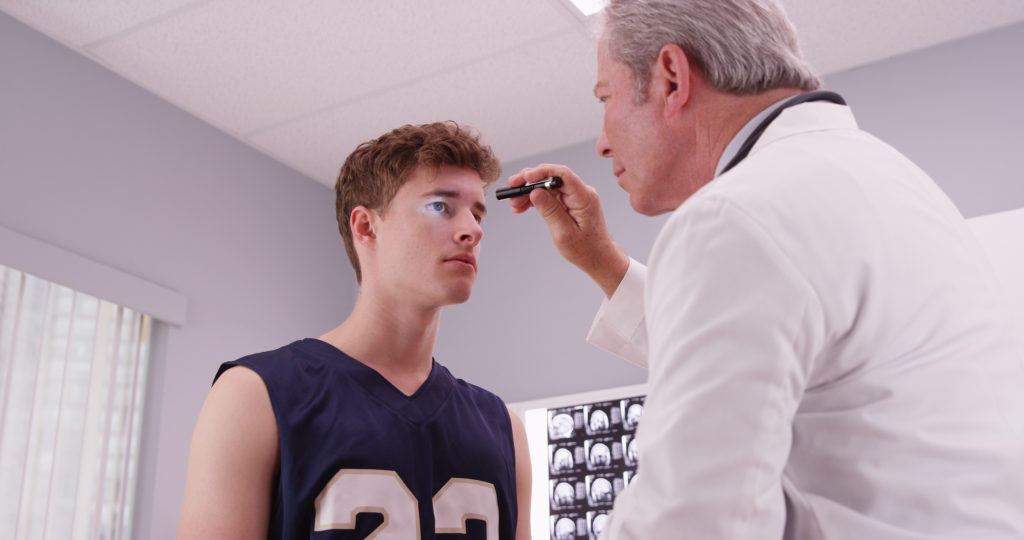
In recent years, concussions on the playing field have received more attention, particularly where youth leagues and school teams are concerned.
What should athletes know to prevent concussions?
How Concussions Happen
The brain is a soft organ surrounded by cerebrospinal fluid. While your skull protects it, the brain can still move around inside.
When a fall or traumatic injury causes the brain to hit the skull, its tissues experience some degree of bruising, also damaging blood vessels and nerves. When this occurs, your brain temporarily stops functioning for a period of time, resulting in a concussion.
Whether the result of a car accident or sports injury, concussions are not always apparent and may take a few days for signs to emerge. Seek medical attention if you experience a combination of the following:
- Dizziness
- Nausea
- Throwing up
- Headaches
- Coordination or balance issues
- Blurry vision
- Slurred speech
- Inability to remember things
- Sleepiness or inability to fall asleep
- Anxiety, irritability, sadness or other unexplained emotions
Although concussions are a risk across all sports, players have a higher risk of experiencing one after:
- A helmet-to-helmet tackle in football
- Heading a ball in soccer
- Taking a fall while skateboarding or biking
- Getting “checked” by another player in hockey
- Running into another skier or snowboarder downhill
Addressing Equipment
While lack of protective equipment on the field increases a player’s risk of concussion, depending on equipment is not absolute. Unfortunately, no concussion-proof helmet or gear exists but padding and sports-appropriate helmets can lessen the impact of a direct blow.
Preventing concussions during a game comes down to two significant factors that work in tangent: Wearing the right protective gear and good sportsmanship.
In terms of proper helmet usage to reduce the incidence of a concussion:
- The helmet should be right for the activity, age appropriate and worn correctly.
- The helmet should fit correctly and not be too loose. Studies have shown that, regardless of sport, only 15 to 20 percent of all players have a helmet that fits appropriately for the activity.
- It should be certified by the National Operating Committee on Standards for Athletic Equipment (NOCSAE).
- During the game, avoid moves in which the head is the primary point of contact – also known as spearing. Not only does this reduce concussions but avoiding head-butting and helmet-to-helmet contact has lessened the number of cervical spine injuries from playing football.
Addressing Behavior On the Field
Helmets and other protective gear can only do so much. Staying safe ultimately comes down to how players conduct themselves, as well as coach and parent attitudes when a player experiences an injury. When the next sports season begins:
- Go over proper tackling techniques in football. Players should not aim for the head.
- Workouts should address strengthening the neck muscles to decrease the impact that passes to the brain.
- Establish clear rules for plays and sportsmanship. Athletes should avoid hitting another player in the head, using their head to go after another athlete, tackling an unprotected individual or intentionally seeking to injure another player.
- If you’re coaching younger players, ensure no one is engaging in full-contact play. Athletes between the ages of 6 and 12 should be working on agility, hand-eye coordination and physical conditioning. For high school and older athletes, make sure you cover appropriate techniques for full-contact moves and stress how certain maneuvers can injure others.
- Avoid using out-of-date equipment. If a piece of sports equipment is old and potentially dangerous, have it replaced with a newer model.
- Know the symptoms so if an athlete appears to be concussed, you know to remove him or her from the field. An injured athlete should not be expected to continue playing through the game.
What If You Experience a Concussion?
If you’re the injured athlete in this scenario, be able to recognize symptoms of a concussion and avoid pushing yourself to continue playing. At this point:
- Stop playing and tell a coach. He or she should take you off the field immediately. Failure to remove the injured player increases the chance of further injury or may result in permanent brain damage or death.
- Make sure your coach conducts sideline testing, a simple series of brain function tests that indicate if you need medical care. At this point, seek treatment immediately.
- Only return to the game when a doctor gives you permission to do so.
Players are generally able to resume practice once the symptoms are gone, their memory and concentration abilities are back to normal and the symptoms don’t return after a basic workout.
If you’ve been sidelined by a concussion and are looking to gradually return to training and practice, get back up to speed by working with one of our certified athletic trainers.
To learn more, contact us today.

